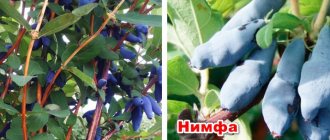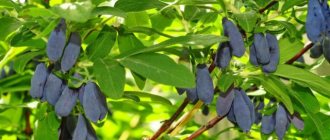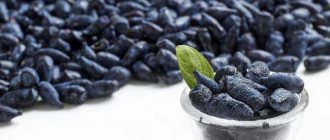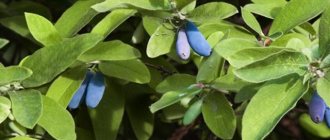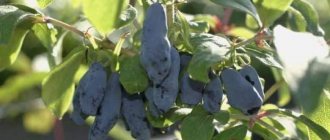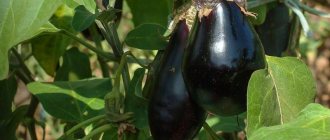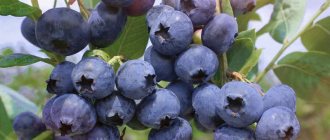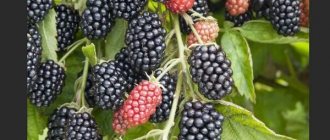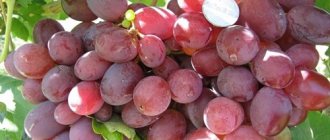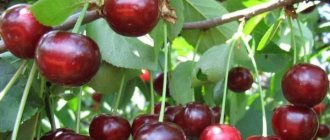Full description of the variety
The honeysuckle variety Nymph is the result of the work of domestic breeders. The berries contain 14.3% dry matter, 8.8% sugars, 2.1% acid, 54 mg of ascorbic acid.
History of selection
The nymph belongs to the blue honeysuckle species, which includes edible varieties. The selection was carried out at the Pavlovsk Research Institute of Plant Growing named after. N. I. Vavilova. The originators of the variety are M. N. Plekhanova and A. V. Kondrikova. The culture was obtained in 1992 as a result of free pollination of the Leningrad giant with pollen of several varieties. It was included in the State Register in 1998 and is recommended for cultivation in any climatic zones.
Did you know? The name "honeysuckle" combines two abbreviated words - "life" and "youth".
Reference. Other names for Nymphs are Gamma, No. 778−11.
Recommended growing regions
Due to its high frost resistance and ability to adapt to different climatic conditions, the variety is suitable for cultivation in all regions of Russia.
Description of the honeysuckle variety Nymph
Previously, honeysuckle was grown only in Siberia, the Urals and the Far East - in its natural growing conditions. But with the development of selection, new varieties began to appear that can be cultivated in almost any climatic conditions. This includes the culture in question.
Nymph - the sweetest variety of honeysuckle
Gardeners enjoy growing honeysuckle in their garden plots. It is not only used as an ornamental plant for vertical gardening - decorating pergolas and gazebos. Honeysuckle is also valued for its very tasty and healthy berries. This is one of the most winter-hardy crops, bearing fruit even in risky farming zones - in the Urals, Altai, and Siberia. Today, the Nymph variety is recognized as unsurpassed in its characteristics.
Appearance, characteristics of berries, ripening time, yield
Characteristics and botanical features of the culture:
- the bushes are tall, up to 2.5 m, but do not grow in width and occupy a fairly small area;
- young shoots are thick, powerful, green, pubescent, old shoots are woody, with flaky bark, brown-sandy in color;
- the foliage is dense, large, lanceolate, green;
- bell-shaped off-white flowers are formed in the leaf axils, collected in 2 pieces;
- ripening period - medium early, depending on climate conditions (mid - end of June);
- The vegetation produces its first harvest 3 years after planting;
- the berries on the bushes stick quite tightly and do not fall off when there is gusts of wind;
- the fruits are colored blue, covered with a bluish waxy coating;
- the shape of the berries is spindle-shaped, the weight of one specimen varies between 0.8-1.1 g;
- the ability to bear fruit is maintained throughout the entire life cycle of vegetation, which can be 30–50 years;
- the yield is higher than that of similar crops, and in industrial cultivation it is 37 c/ha, in private farms - 1.5–2 kg per plant;
- The frost resistance of the bushes is high - they can winter without shelter at -50°C, the flowers tolerate return frosts down to -7°C;
- Plants exhibit increased resistance to diseases and pests and are occasionally attacked by aphids.
The characteristics of the fruit deserve special attention. A distinctive feature of Nympha berries is their sweet taste; their sugar content reaches 9%, while in other edible varieties acid predominates. Honeysuckle fruits are very useful. They contain a number of vitamins and minerals necessary for the full functioning of the human body:
- riboflavin;
- thiamine;
- ascorbic acid;
- phylloquinone;
- beta carotene;
- potassium;
- calcium;
- sodium;
- phosphorus;
- magnesium;
- iron.
Bushes
This type of honeysuckle shrub is erect and tall (reaches a height of up to 2 meters), has an oval spreading crown with slightly pubescent shoots and large leaves of the same shape with pointed ends.
Important! The unique decorative properties of honeysuckle “Nymph” play an excellent role in landscape design in the form of hedges. The shoots are brownish-green, and the leaves are dark green. The main part of the leaf has a slightly wavy flat surface with a base in the shape of a wide oval.
Berries
The excellent taste of the berries of this honeysuckle variety is represented by a combination of sour and sweet flavors with a certain hint of astringency, which gives sophistication and unusualness to the fruits. Large spindle-shaped or ellipsoidal blue berries with a slight amethyst tint, as well as a thick waxy coating, will delight gardeners with their appearance at the end of June.
Did you know? The well-known “wolfberry” is also a type of honeysuckle, but inedible, and on the contrary, has a toxic effect on the body. Safe berries are distinguished from poisonous ones by their color: you can only eat fruits of a cold, dark shade (black and blue), and flashy bright colors (red, orange) seem to warn of a possible health risk. The advantage of honeysuckle “Nymph” is the reliable attachment of the fruits to the branches, which allows them not to fall off for a long time and delay harvesting (in case of lack of time).
Pollinator varieties for honeysuckle Nymph
Honeysuckle Nymph is a self-sterile variety, so other similar berries with the same flowering time should be planted next to this berry bush.
The best pollinating varieties for honeysuckle Nymph:
- Moraine;
- Amphora;
- Viola;
- Blue Spindle. There is no special need to attract flying insect pollinators - this berry perennial is an excellent honey plant.
Ripening period, yield and fruiting
This is a mid-early variety - the harvest ripens in mid-late June. The bushes begin to bear fruit 3 years after planting and remain productive for 25–30 years.
The average yield is 1.3–2 kg per bush, with industrial cultivation - 37 c/ha.
When does it ripen?
The readiness of the fruit depends on the region of growth. In the middle zone, the fruits ripen in June. The variety belongs to the mid-early category. But in practice, ripening can be delayed for a whole month.
Productivity of the honeysuckle variety Nymph
With good care, you can collect up to 2 kg of ripe fruits from one bush, but on average the yield of Nymph honeysuckle is 1.0-1.2 kg. When growing this berry bush on an industrial scale, 36-38 centners are harvested from one hectare.
Need for pollination
Nymph is a self-sterile variety. To obtain a harvest, other varieties of honeysuckle are planted nearby. Honeysuckle that blooms at the same time as the Nymph is suitable - you can plant, for example, “Amphora”, “Chosen One”. "Pavlovskaya".
Photo of honeysuckle Nymph
The fruits of this shrub are medium in size, weighing 0.9-1.2 g, spindle-shaped, slightly elongated. The skin is lumpy, compacted, blue in color with a waxy coating, which makes it appear blue. Ripe fruits adhere well to the stalks and practically do not fall off after ripening. The taste of Nymph honeysuckle berries is not bad; the fruits have a sweet taste, pleasant aroma and a slight bitterness. Expert rating: 4.7 points. The harvested crop is universal; ripe berries can be eaten fresh, frozen for the winter, or made into jam, compotes or jams.
Description of the bush and berries of Nymph
Brief botanical description of honeysuckle Nymph:
- Bushes. Tall, slightly spreading. The branches are thick and straight. Annual shoots are light green and covered with villi.
- Leaves. Large, elongated oval, dark green with slight pubescence. The height of the bush is up to 2.5 m.
- Flowers. Large, bell-shaped, pale colored.
- Fruit. Weight – 0.8-1.1 g. Shape – elongated fusiform, surface – tuberous. The skin is moderately thick. The color is blue-bluish. The taste is sweet, with a spicy bitterness. The pulp has a pleasant aroma. The variety received a high tasting score - 4.7 points out of 5.
Characteristics of the variety
This is a slightly spreading, vigorous (up to 2.5 m high) bush with powerful, erect, pubescent young shoots of light green color. Old branches are woody, covered with flaky brown-sandy bark.
The leaf blades are large, elongated-oval, with a wide-rounded base, dark green and covered with light, hard fluff. During flowering, large pale bell-shaped flowers are formed in the leaf axils, collected in inflorescences of 2 pieces.
The berries have a lumpy surface, medium size, weigh 0.8–1.1 g, and have an elongated spindle shape. They are covered with a medium-thick blue skin that looks bluish due to a waxy coating. The pulp is fibrous, with a pleasant aroma and sweet taste with a spicy bitterness. Tasting score: 4.7 points.
Specifications
Fruit ripening period: late (end of June).
Bush: medium (1.5-1.7 m) and tall (1.7-2 m) with a dense oval crown.
Shoots: long and straight, slightly pubescent.
Leaves: large, elongated oval with a broadly rounded base and pointed ends.
Berries:
- average weight - 1.6 g, maximum - 3 g;
- shape and size: ellipsoidal-elongated/spindle-shaped (average berry length - 28-30 mm, diameter - approximately 10 mm);
- surface: bumpy;
- taste characteristics: pronounced sweet and sour taste and rich pleasant aroma;
- pulp structure: fibrous.
Important! The exceptionally rich set of vitamins and minerals contained in honeysuckle allows it to be used for medicinal purposes. Berries have a beneficial effect on the cardiovascular and digestive systems, and thanks to their diuretic and choleretic properties, they perfectly cleanse the body of toxins and other harmful substances. The maximum yield reaches 3 kg per bush.
Early fruiting is quite developed: the plant gives a harvest in the 3-4th year after planting and will give birth within 25-30 years.
Features: high cold resistance.
Resistance to diseases and pests
The shrub is resistant to diseases and pests, but if agrotechnical requirements are violated, it is affected by sooty fungus, powdery mildew, tubercularosis, and damaged by scale insects and honeysuckle mites.
Resistance to cold and drought
Nymph is a frost-resistant honeysuckle. Shoots tolerate drops in air temperature down to -50°C, roots - down to -40°C, and buds, flowers and ovaries do not die during return frosts down to -6...-8°C.
The variety does not tolerate drought well: lack of moisture leads to a slowdown in the development of bushes, a decrease in the quality and quantity of the harvest. Waterlogging of the soil provokes rotting of the roots and creates a favorable environment for powdery mildew.
Advantages and disadvantages
The variety is not the newest; it is already 20 years old. Even though the Nymph is not as large-fruited as the Giant’s Daughter, and its yield is significantly lower than that of the Bakcharsky Giant, all the qualities of this honeysuckle are time-tested. Its advantages include:
- High nutritional and medicinal value of berries.
- Possibility to grow the variety throughout Russia.
- Stability of fruiting.
- Low susceptibility of Nymphs to aphids.
- High winter hardiness.
- When ripe, the berries almost never fall off.
- Taste qualities – 4.7 points.
- Easy to care for.
- The high decorativeness of the bush allows you to use the Nymph to decorate the area.
- The productive period is up to 30 years.
Among the disadvantages of honeysuckle variety Nymph, in addition to self-sterility, are:
- Insufficient yield.
- Light weight of berries.
- Instability to re-blooming, especially in the southern regions.
But let's not forget that the variety was created at the end of the last century. The fact that it is inferior to the latest cultivars speaks not of its shortcomings, but of a high level of selection.
Advantages and disadvantages
Nymph's advantages:
- excellent taste and rich chemical composition of berries;
- possibility of cultivation in all regions;
- long productive period;
- frost resistance;
- stable yield;
- good immunity;
- lack of tendency to fruit shedding;
- ease of care;
- decorativeness of bushes.
Disadvantages of the variety:
- low yield;
- the need for regular crown thinning;
- need for pollinating varieties;
- demands on the level of soil moisture.
Differences from other varieties and hybrids
A comparison of Nymphs with other mid-early honeysuckle varieties is presented in the table:
| Variety | Berry weight, g | Taste | Berries shape | Productivity, c/ha |
| Nymph | 0,8–1,1 | Sweet, bitter | Elongated fusiform | 37 |
| Moraine | 1 | Sweet and sour | Elongated pitcher-shaped | 53,3 |
| glass | 0,8-0,9 | Pitcher-shaped | 113,2 | |
| Samara | Up to 1 | Sweet | Cylindrical | 100 |
Advantages and disadvantages of the variety
This variety is already more than two decades old, but it is one of the most popular honeysuckle varieties among summer residents due to its obvious advantages:
- The composition of the berries is distinguished by their high nutritional and medicinal value;
- the variety can be grown in almost all Russian regions;
- fruiting is stable;
- the plant is practically not affected by aphids;
- When ripe, the fruits are practically not prone to shedding;
- no special care is required for this shrub;
- bushes of the Nymph variety are highly decorative, so this variety is often used to decorate the garden;
- The variety actively bears fruit for 29-30 years.
Honeysuckle Nymph - photo
But this honeysuckle also has disadvantages that you need to know about:
- self-sterility;
- low yield;
- small fruits with little mass;
- The variety is not resistant to re-blooming, especially in the south of Russia.
Varieties of berries!
Blueberry Elizabeth
Honeysuckle Nymph Reproduction
Honeysuckle Nymph can be propagated in different ways. But when propagated by seeds, new seedlings will not inherit varietal characteristics. When propagated by cuttings, only 1/5 of the rooted seedlings take root. Therefore, in garden plots it is easiest to propagate the Nymph honeysuckle shrub by dividing the bushes or layering.
Seeds
This method of reproduction is ineffective and takes a lot of time. A bush grown using this method can produce both a good and a bad harvest. Seeds are collected from ripe berries. You can plant directly in open ground (in early spring), or in a container with fertile soil. The recommended temperature for seed growth is minus 23 degrees. The first shoots will appear in a month.
Dividing the bush
This method is used when the honeysuckle reaches eight years of age. An adult plant has strong bark; you have to use an ax to divide the bush. Each of the bushes must have a root system of at least 20 centimeters, from which two stems extend. They are immediately planted in a hole up to 50 centimeters deep. Water and mulch.
Cuttings
One of the most commonly used propagation methods. After the green fruits appear, preparations for cuttings begin. To do this, cut the shoots at least about 12 centimeters, leaving three nodes. The cut is made at an angle. The cuttings are planted in a greenhouse. After three weeks, roots appear on the seedlings. For the winter, the plant should be left in a warm place, and after the snow has melted, planted in open ground.
How to propagate honeysuckle - video
Reviews
Honeysuckle is a bitter berry, so choose new varieties that are not bitter and high-yielding. Nymph is very tasty, sweet, without any bitterness at all.
Lyudmila
https://www.babyblog.ru/community/post/ogorod/3142501
Honeysuckle is generally low-yielding; 1–2 kg from a very large bush is probably a record. Of my seven varieties, Nymph turned out to be the sweetest. Almost no acid, despite the bad weather in May-June.
LenaRya
https://www.websad.ru/archdis.php?code=47401
I counted 13 honeysuckle bushes in my home. They were pollinated differently. The best of all are Nymph, Leningrad Giant, Bakcharskaya, Vitaminnaya. The sweetest is Nymph.
Vitaya
https://www.sadiba.com.ua/forum/showthread.php?p=903974
Honeysuckle Nymph is an unpretentious and durable plant that maintains productivity for many years. The cold-resistant crop easily tolerates harsh Russian winters, and its fruits ripen already in mid-June. Gardeners are also attracted by the decorative nature of Nymphs - bushes are often used to decorate the landscape and erect hedges.
Planting honeysuckle Nymph
Honeysuckle Nymph is not a capricious plant. Buying seedlings is not so easy; it is not particularly popular among gardeners. Still, it’s worth planting it on the site, because Nymph is a real treasure trove of vitamins. Ascorbic acid contains 54 mg per 100 grams of product. It is worth planting plants of the same flowering period. The distance between honeysuckle is about a meter, then adult bushes will not interfere with each other.
After the plant is planted, it is necessary to provide proper care for it. Honeysuckle is not picky. Watering, pruning, weeding, removing weeds and controlling pests is all that is necessary to obtain a rich harvest.
Landing dates
The best period for planting honeysuckle Nymph is autumn. By August, the upper buds form in the plants; until the onset of warm spring days, the plants are in a dormant state. You can plant it in the spring, but you shouldn’t wait for the harvest early. The earlier the nymph is planted, the better. The planting date affects the appearance of fruits. Honeysuckle planted in late spring does not acclimatize well and may die. If you suddenly had to plant it in the last month of spring, then the bush is placed in a hole along with the soil in which it grew.
Important! If you plant a nymph in September, the berries will appear before the strawberries are ripe.
Selecting a location
Honeysuckle loves moist soil, but does not tolerate stagnant water. Gardeners noticed that during the season with high moisture, there were more fruits on the bush. During the drought, the quality of the berries deteriorated. Since the plant is light-loving, slightly darkened areas are allowed. The place where the bush grows must be protected from drafts and winds; they break off branches and throw off the harvest. A flat or slightly sloping area will do. Do not plant in sandy or swampy soils. The soil is slightly acidic (pH 5.5-6.5). The most suitable is chernozem, soddy-podzolic soil.
Selection of seedlings
You can purchase seedlings in a special nursery. Before purchasing, you should inspect the plant to ensure there is no damage to it. It is better to choose three different varieties, they will cross-pollinate, this will increase the number of fruits. It is not recommended to purchase plants taller than 150 centimeters; they do not adapt well to new conditions. Preference is given to berries without bitterness, which are in containers or bags. The roots of honeysuckle are protected, which makes it easier for the plant to adapt to a new location.
Distribution of honeysuckle in nature
The main areas of distribution of honeysuckle in our country are Eastern Siberia, the Far East, the northern regions of the European part in the Leningrad region, the Urals, the Central Black Earth and middle zones, Moscow and the Moscow region.
Honeysuckle is a northern plant. The distribution area reaches the Arctic. It is practically insensitive to frost, but reacts very painfully to elevated temperatures and especially to autumn-winter thaws. Therefore, in the southern regions of Russia, Ukraine, Moldova and other warm zones, honeysuckle grows poorly and develops poorly. These climatic conditions are not suitable for her. So the word is up to the breeders.
Honeysuckle flowers. John Kitsteiner
Growing honeysuckle
Honeysuckle is easy to care for, it is not capricious and rarely gets sick. The main thing is to choose the right place and plant the plant.
Caring for a young plant
Only young honeysuckle requires close attention in the year of planting. It needs to be watered regularly so that the root does not dry out. When the top layer of soil dries a little, the soil is loosened to a depth of 5-8 cm. Weeds are removed from the tree trunk circle.
If fertilizers have been added to the planting hole, the first 2 years are limited to spring nitrogen fertilizing. It is better to do it on snow that has not yet melted - add ammonium nitrate or urea to a bucket of water according to the instructions and water the honeysuckle.
Caring for an adult plant
Adult bushes are watered as needed, the soil is loosened and weeds are pulled out. The tree trunk circle is mulched with organic matter. The annual spring feeding after fruiting of honeysuckle is given a full mineral complex, and in early autumn - phosphorus-potassium fertilizers.
Accommodation on site
Honeysuckle Nymph grows well throughout the Russian Federation. It can be called a variety for those who do not like surprises.
Selection of planting material
In order for honeysuckle to take root better, you need to select seedlings at the age of 2-3 years. It should have several well-developed strong branches with equal internodes. Buy container plants whenever possible. If the seedling has an open root system, pay attention to it - there should be no severe damage, black spots or signs of rot.
Comment! In lignified areas of shoots, the bark may peel off - this is a feature of the species, and not a sign of trouble.
Selecting a suitable location and preparing the soil
It is important to choose a sunny area protected from strong cold winds for planting edible honeysuckle. All kinds of depressions, lowlands or depressions are not suitable due to possible stagnation of water and accumulation of cold air.
Important! In the shade, honeysuckle bears little fruit.
The Nymph variety will grow on any soil, but will produce the best yields on loose, fertile, slightly acidic soils. Sandstones do not contribute to setting a large number of large berries. Acidic soils need liming - adding 200-400 g of fluff into the planting hole.
Honeysuckle Nymph can be planted according to the standard pattern - 1.5 m between plants, rows - at a distance of 2 m from each other. The variety looks very beautiful; the bushes can be placed around the perimeter of the site to cover less attractive low-growing crops.
Planting honeysuckle
Planting holes for honeysuckle are dug 40x40x40 cm in size. Then a bucket of humus or compost is mixed with the top fertile layer of soil, phosphorus and potassium fertilizers (50 g each). Then:
- Fill the planting hole with water.
- When it is absorbed, pour a slide of the nutrient mixture in the middle.
- A seedling is placed on top.
- The roots are straightened around the mound.
- Fill the hole with soil so as to deepen the neck by 5 cm.
- Carefully compact the earth.
- Water the honeysuckle, spending at least 10 liters of water per bush.
- Mulch the tree trunk circle with peat, humus or dry soil.
Important! The Nymph variety is best planted in autumn or late summer. Then the survival rate of honeysuckle will be 95-97%. When planting in spring, this figure drops to 82-85%.
Further care for honeysuckle variety Nymph
After planting, young Nymph honeysuckle plants require constant watering so that their root system does not dry out. Some time after watering, you need to loosen the tree trunk circles and at the same time remove weeds. Adult plants are watered as needed, and the soil is loosened and weeds are removed.
Watering
In the first five years after planting, the nymph bush grows slowly and the yield is low. From the sixth year you can collect up to 2.5 kg per bush. To do this, it is worth taking a whole range of measures. One of the main ones is watering. During the period when inflorescences and fruits appear, it is worth watering every day (one bucket per bush). On hot days, increase the moisture to two buckets. A large amount of liquid does not have a very good effect on the berries, they will be large and watery.
The plant is moistened in two ways:
- Surface watering, moisturizes the tree trunk area under the bush;
- Irrigation is carried out in the first month of summer. The disadvantage of this method is the presence of special equipment. Suitable for light soils only.
For maximum effect, you should follow certain recommendations:
- Water for humidification must be used that has been settled.
- Do not loosen the soil deeply, as this can damage the roots.
- The proximity of groundwater will do more harm than good.
Some gardeners practice watering the nymph bush with boiling water. In their opinion, this does not harm the plant, but rather helps in pest control. Carry out the procedure of watering with boiled water after the snow has melted. The soil has not yet had time to melt. Using a watering can, water the frozen soil under the honeysuckle. The roots will not be harmed, the water will cool while it passes through the soil.
Feeding the honeysuckle variety Nymph
If all the necessary fertilizers were added to the holes when planting, then in the first two seasons it is enough to apply fertilizing containing nitrogen in early spring.
Fertilizing plants with potassium nitrate
Subsequently, in early spring, nitrogen-containing fertilizers are applied to the Nymph honeysuckle, and after harvesting, a complex mineral fertilizer is applied. When preparing the shrub for winter, fertilizers containing phosphorus and potassium are applied to the tree trunk circles.
Loosening and weeding
After rain or watering, it is recommended to carefully loosen the soil under the bush, removing weeds and fragments of their roots. When loosening, it is important not to overdo it, since the root system of the bush is superficial, the roots are located dangerously close to the soil level. Therefore, they loosen the soil no deeper than 5-8 cm.
An alternative to periodic loosening is mulching. This retains moisture and inhibits the development of weeds, which significantly saves the gardener’s time and effort.
When and how to prune honeysuckle Nymph
Pruning of the bush is carried out from the 3-4th year after planting, when the honeysuckle begins to thicken. It is better to do this in the fall. First, the null stems growing directly from the ground are cut out. Then diseased, broken, dried out or very short branches are removed, as they will not bear fruit productively. For high-quality fruit formation, it is necessary to thin out the bush so that the sun penetrates through the foliage and shoots.
The berries are formed on strong one-year-old stems, so to ensure a generous harvest, do not touch the current year's shoots. Stems with weak growth are trimmed if their base and middle part are visually strong. Unproductive or drying branches are also cut out at the base. Unsuccessfully growing shoots that interfere with proper cultivation of the soil in tree trunk circles are also removed. The old bush is rejuvenated by completely pruning all the stems, leaving only young shoots.
In spring, sanitary pruning is necessary, the purpose of which is to remove frost-damaged, broken or diseased shoots. By pruning, they increase the decorativeness and increase the fruit formation of such a crop as Nymph honeysuckle. The photos presented in the article not only demonstrate the exquisite elegance of this garden beauty, but also emphasize its very high potential for yield.
Trimming
Pruning is carried out three years after planting the bush. Mostly fruit buds form on young branches. Therefore, it is necessary to prune old shoots, giving the opportunity for the development of young ones. Upon reaching the age of six, the bush is rejuvenated by cutting off almost all branches.
Important! There is no need to cut off the tops of honeysuckle; the buds and inflorescences are located there.
Rules for pruning honeysuckle in spring - video
Preparing for winter
The nymph honeysuckle variety is frost-resistant. It can easily withstand frosts of -50 degrees, the roots remain alive at a soil temperature of -40. Before wintering, the branches of the bush are bent to the soil and tied. This will help keep the branches intact if the winter is snowy. Decorative varieties, often used in site design, are covered with film or fabric material. Before the onset of cold weather, water the plant with humus and mulch it.
Nymphal honeysuckle berries ripen unevenly; harvesting is carried out several times a season; it should not be postponed. Desserts, compotes, jam are made from the fruits and consumed raw.
Productivity and pollinators
The very average yield of the crop (up to 1.3 kg per bush) increases noticeably with the planting of various pollinating varieties nearby. Planted with a crop such as Nymph honeysuckle, varieties with the same flowering periods so that cross-pollination is as productive as possible. The most successful in this role are the late-ripening varieties Amphora and Violet, as well as Viola, Morena and Blue Spindle. Honeysuckle Nymph, the pollinators listed above, are planted in a permanent place with an interval between them of at least 1.2-2 m.
Let's learn about the rules for planting this berry bush.
Features of fruiting and harvesting
Honeysuckle Nymph is a non-falling variety, so you can take your time harvesting it in stages as the berries ripen. Gardeners who are familiar with the variety first-hand advise waiting 5-7 days and harvesting in one go.
Honeysuckle fruits are covered with a delicate thin skin that is damaged if handled carelessly. Therefore, when picking, use shallow dishes, laying the berries in a thin layer. Honeysuckle Nymph is no exception to the general rule. Reviews from gardeners emphasize their delicate structure and the impossibility of long-term storage. The harvested crop is processed almost immediately; the berries are not stored for more than 2-3 days, even in the refrigerator.
Harvesting
A two-year-old seedling will produce its first fruits a year after planting. In the middle zone, honeysuckle ripens by early June - earlier than raspberries or strawberries.
Nymph's fruits do not ripen at the same time, and the entire harvest will be ready later - by mid-June. The berries are stored in the freezer, they can be dried, used in cooking, or prepared for the winter.
Harvesting and transportation, keeping quality of berries
Harvesting can begin a week after the berries begin to turn blue. The easiest way is to spread film under the bushes and shake them. The remaining berries are removed by hand. The harvest is immediately sorted, discarding damaged fruits. Place the berries in a single layer in small containers lined with paper. In the refrigerator, ripe fruits remain fresh for no more than 3 days. If you plan to use the crop in commercial activities, then it should be transported immediately after harvest. To extend shelf life, it is better to freeze the berries or send them for processing. The berries can be used to make jams, preserves, a variety of tinctures and liqueurs.
Fruit
The fruits deserve special attention - blue-violet berries with a thick waxy coating, elongated in shape and with an uneven, bumpy surface. The fruits are large, spindle-shaped, sometimes curved, reaching a length of 2.5-3 cm and a weight of 0.9-1.2 g. Their taste is remarkable - sweet and sour with a pleasant astringency. The advantage of the variety is the fact that the berries are firmly attached to the branches and do not fall off, which is the problem with many varieties of honeysuckle. It is the large fruit and taste properties that make Nymph honeysuckle stand out. Reviews from gardeners who have already become acquainted with this variety are unanimous: the culture is really good.
We will not list all the advantages of honeysuckle fruits, we will only note that rare garden plants can compare with these dove-blue berries in terms of their saturation with useful substances that act on the human body as a healing balm. Let us add that the Nymph honeysuckle variety is universal: the fruits are excellent for both fresh consumption and for any culinary processing or canning.
Diseases and pests
The Nympha honeysuckle variety is highly resistant to major diseases, but the resistance of this shrub to powdery mildew is low. The main conditions for the occurrence of this disease are cold rainy weather or moisture getting on the foliage during evening watering.
Preventive treatments of the bush should be carried out against this fungal disease. If the first signs of powdery mildew appear on the vegetative mass of the plant, then fungicidal preparations should be used. During the ripening period, it is better to use Fitosporin solution or folk remedies.
The Nymph variety is highly resistant to aphid attacks. But it is often affected by leaf rollers or scale insects. These insect pests should be treated with solutions of insecticidal preparations or biological agents:
- Agrovertin;
- Spark-bio;
- Fitoverm.
Shchitovka
If a plant becomes infected with these insects and is not treated, the bush dies as it quickly loses the juice in the leaves and stems. To prevent scale insect attacks, it is enough to spray the honeysuckle with Rogor after harvesting and repeat the procedure again after 10 days.
When aphids attack honeysuckle, the plant's leaves and stems very quickly lose their vitality - they turn yellow, fall off, and new shoots do not develop. As soon as you notice pests, take appropriate measures - high control efficiency is observed when treating plants with Actellik, Confidor, Rogor, Karate, Kinmiks, Entobacterin, Biotlin.
Important! The storehouse of folk remedies also contains suitable ones - infusions of chamomile, pepper, garlic, tobacco, onion, pine needles, calendula, soda ash.
Caterpillars
The caterpillars must be dealt with immediately mechanically - just collect them by hand. But if there are a lot of pests, it is advisable to spray honeysuckle. Suitable drugs for this purpose are Inta-Vir, Eleksar.
Ticks
Mites, like aphids, also very quickly suck the juice from the plant. Signs of infection include curled, brown or black leaves covered in holes. Treatment with anti-tick agents is mandatory in this case. The options “Mavrik”, “Tedion”, “Omite” are good options.
Fungi and rot
To prevent plant rotting, it is best to do without chemicals, but treatment must be carried out in advance. The optimal solution is 1 tablespoon of laundry soap and 10 liters of water. To enhance it, you can add 10 g of copper sulfate powder.
Important! Honeysuckle can also be attacked by cherry fly, leaf roller, whitefly, mosaic, powdery mildew, cercospora blight, and rust. It is not necessary to carry out prophylaxis with chemicals against each of the possible options. It is better to use folk remedies in the form of universal solutions that will repel most pests. But this must be done in a timely manner.
The Nymph variety is universal, and therefore valued by gardeners in different regions. If you are planning to add honeysuckle to your plot, this option will definitely not cause you any problems and will delight you with the beauty of the bush and delicious berries.
Preventive actions
To protect the plant from diseases, preventive spraying with Bordeaux mixture is carried out before and after flowering. If the bush is attacked by aphids, mites or other pests, use insecticides. But they are not used during fruit ripening, otherwise the poisons will accumulate in the fruits.
Common honeysuckle diseases and their treatment:
| Disease | Symptoms | Prevention | Treatment |
| Sooty fungus | A dark coating appears on the leaves. With severe damage, the plant weakens. | Remove fallen leaves. | Two treatments with 1% Bordeaux mixture - before flowering. The interval between spraying is a week. Or treatment with Fundazol 1% or Zineboy (per 10 l - 8 g) |
| Powdery mildew | There is a white coating on the leaves, they dry out. The winter hardiness of the plant decreases. | Avoid dense plantings and waterlogging of the soil. | Spraying with Topsin-M 1%, Fundazol 0.2%. |
| Tuberculariosis | Red-brown compactions with fungal spores appear on the shoots. | Pruning in a timely manner. Destroy damaged shoots. | At the beginning of the growing season - spraying with 1% Bordeaux mixture. |
Agricultural technology
Caring for honeysuckle Nymph includes regular moistening of the soil, fertilization, weeding, pruning, and preventive measures against diseases.
Watering and loosening
In the first 2 years, only watering and weed removal are carried out. The culture loves moisture, but does not tolerate waterlogging. Water the honeysuckle 4–6 times per season with 10–15 liters of water per bush. The crop especially needs moisture during flowering and fruit formation. Lack of water negatively affects the taste of berries and the size of the harvest.
Recent Entries
5 working ways to use tar in the garden 7 indoor plants that help you get married even in adulthood Indoor plants that can bloom in trouble
The berry plant especially needs moisture during flowering and fruit formation.
To improve pollination and attract bees to the garden, during the appearance of buds, experienced gardeners advise spraying honeysuckle with a solution of sugar or honey (2 tbsp.\10 l).
After rain or watering, carefully loosen the soil. Since the roots of honeysuckle are located close to the surface, loosening is carried out to a shallow depth of 8 cm. A layer of mulch 10 cm thick can also be used to keep the soil moist and inhibit the growth of weeds. Hay, straw, sawdust, and humus are used as mulching materials.
A layer of mulch around the honeysuckle bush helps retain moisture and discourages weed growth.
Feeding
In the first two seasons, honeysuckle is not fed; it has enough nutrients added during planting. In the third year in the spring, the berry garden is fertilized with ammonium nitrate (30 g\10 l). When the buds open, 10 kg of humus is added under the bush, and at the end of August - 400 g of ash. Before the onset of cold weather, preparing the bush for wintering, the soil is fertilized with 5 kg of compost, 100 g of ash, and you can add 40 g of superphosphate (per 1 m2). Once every three years at the end of the season, it is recommended to feed honeysuckle with potassium fertilizers (15 g/m2), which increase the plant’s resistance to disease.
Before flowering, it is useful to carry out foliar fertilizing with natural fertilizer HB 101 (1 ml\20 l\m2). This drug is produced from plantain, pine, cypress and Japanese cedar, contains silicon and is a growth activator, strengthens plant immunity.
Wood ash is an effective natural fertilizer containing potassium, phosphorus, calcium and other minerals necessary for honeysuckle.
Video: honeysuckle care
Trimming
The first three years do not form the bush. In subsequent seasons, dry, diseased and broken branches are removed in the fall. From the age of 6, anti-aging pruning is necessary. Cut out 2 old branches at the base and leave 3 young shoots. Gradually, by the age of 15, the bush is completely rejuvenated.
Pruning allows you to get a well-lit and ventilated bush
When honeysuckle grows strongly, the crown must be thinned out. This is necessary so that the sun evenly illuminates the entire berry garden, and pollinating insects easily penetrate to the middle of the bush.
Reproduction methods
You can grow honeysuckle from seeds, cuttings, layering and by dividing the bush.
- The seed method is quite labor-intensive and is used mainly for breeding experiments.
- It is easy to propagate honeysuckle by dividing the bush. A well-developed bush is divided into parts with roots, skeletal branches and young shoots. A division with branches shortened to 45 cm is planted in a prepared place.
- Most often, the cutting method is used to propagate berry crops. Lignified cuttings are harvested at the end of the season: the annual growth is cut into 15-centimeter pieces and stored in the basement until spring. At the end of March they are planted in a greenhouse, leaving one bud above the surface. The soil is regularly moistened and the greenhouse is ventilated. After a month, the cuttings will form roots.
Honeysuckle cuttings are cut in the fall and stored in the basement until spring.
- When propagated by green cuttings at the beginning of summer, the shoots are divided into parts 12 cm long and planted in containers with a nutritious soil mixture, watered, covered with film, regularly ventilating and moistening the soil. Rooting occurs within a month. The cuttings are planted in a permanent place next fall.
- Honeysuckle is also propagated by apical layering. The tip of the shoot is buried in a groove under the bush, secured with a bracket and watered. The cuttings take root in a month, but they should be separated and planted in the fall of the next season.
A fairly simple way to propagate honeysuckle - by apical layering
Video: propagation of honeysuckle by green cuttings
Preparing for winter
Honeysuckle is a cold-resistant plant; it is not for nothing that in nature it lives mainly in northern latitudes. Therefore, the culture does not need insulation. On the eve of cold weather, they only carry out moisture-recharging irrigation and mulch the soil with humus. In very severe winters, the tips of the shoots may be slightly damaged by frost, which are removed in early spring.
Disease Prevention
Honeysuckle Nymph has good immunity. But under unfavorable weather conditions, signs of disease damage to the bush may appear. Timely preventive measures will prevent the appearance of pests.
Table: honeysuckle diseases
| Diseases | Symptoms | Prevention | Treatment |
| Powdery mildew | The leaves become covered with a white coating, dry out, and the winter hardiness of the crop decreases. |
| Spray the bushes before flowering with 1% Topsin-M, 0.2% Fundazol, 0.4% Zineba. |
| Sooty fungus | A dark coating forms on the foliage. With significant damage, the plant quickly withers. | Remove fallen leaves. | Before flowering, treat twice with an interval of 7 days with 1% Bordeaux mixture, 1% Fundazol, Zineba (8 g\10 l). |
| Tuberculariosis | Red-brown tubercles form on the shoots, in which fungal spores develop. |
| At the beginning of the growing season, spray with 1% Bordeaux mixture. |
Photo gallery: diseases that can affect honeysuckle
Long rains contribute to the development of powdery mildew on honeysuckle
Honeysuckle affected by sooty fungus quickly loses its strength
Increased air humidity creates optimal conditions for the development of spores of the fungus tuberculosis
Table: honeysuckle pests
| Pests | Manifestations | Prevention | Measures |
| Shchitovka | Scale insect larvae, appearing in early spring, attach themselves to the shoots, covering them with a dense shield. By feeding on plant sap, pests cause the bush to dry out and die. |
|
|
| Honeysuckle mite | The appearance of the pest is facilitated by thickened or shaded plantings. The mite sucks the juice of leaves and fruits. The leaves curl and fall off. | Thin out the bush. |
|
| Zlatka | The beetle larva gnaws out the branches from the inside, and the shoots dry out. |
|
|
Photo gallery: insect pests of honeysuckle
Scale insect larvae stick to honeysuckle shoots
Honeysuckle mites develop quickly in humid conditions.
Lace borer larvae climb inside branches
Birds like honeysuckle berries. To protect the harvest from birds, when the fruits ripen, you should cover the bushes with a protective net.
Problems you may encounter
Problems possible when growing the Nymph variety:
- The main problem when growing Nymph honeysuckle is damage from aphids and other insects. Spraying with insecticides and biological products - Fitoverm, Iskra-bio or others - helps solve the problem.
- In rainy summers, as well as with overhead watering, the crop may be affected by powdery mildew. The solution is spraying with fungicides. If the disease attacks after the formation of fruits, folk remedies are used.
- Honeysuckle Nymph does not tolerate hot, dry summers. If drought occurs, abundant watering and mulching solve the problem.
Harvesting
Nymph honeysuckle berries ripen at the beginning of summer at different times. Fresh fruits are stored in the refrigerator for only 2-3 days, therefore, in order to preserve the healing berries for a longer period, they are frozen, dried, prepared in sherbet, fruit juice, compote, and added to desserts and baked goods.
Jam with the addition of strawberries is especially tasty.
Honeysuckle fruits are consumed fresh, dried, and prepared into compotes and jam.
Honeysuckle contains many vitamins and minerals, so it is recommended to include it in the diet of people with heart, vascular, and eye diseases. The juice is used to treat lichens and ulcers. And medicinal teas are prepared from dried honeysuckle leaves, recommended for skin diseases and kidney diseases.
How and when to plant
Garden honeysuckle is not distinguished by its capricious character. Purchasing seedlings is still quite problematic, because this plant is not perceived by everyone as a garden plant. Despite this, the value of the berries is very high, so you should definitely find some space on your site for this shrub.
But what late blight disease in tomatoes looks like, and what you should pay attention to, is indicated here. Rules for planting this crop:
Rules for planting this crop:
- It is best to plant in late summer to mid-autumn. Spring planting gives less chance of successful acclimatization.
- Choose a planting site that is sunny but protected from drafts. It is best to place bushes in group plantings.
- The holes must be made small, approximately 40x40 centimeters.
- Fertilizers are applied to the bottom of the planting hole. For one bush, a bucket of humus, 200 grams of superphosphate and 30 grams of potassium salt will be enough.
- When planting, it is necessary to deepen the root collar a couple of centimeters. The soil around the stem is compacted tightly and watered well.
- The root zone is mulched to prevent moisture loss.
But you can read here how to properly plant an apple tree seedling in the fall.
Video shows how to plant honeysuckle:
After planting, the seedling usually needs a little time to acclimatize. If you purchase two-year-old seedlings, you will be able to taste the first harvest the very next year after planting. Buying a three or four year old bush will cost a little more, but usually older plants take root less well and tolerate transplanting and transportation. It will also be interesting to learn about how to grow the plum variety Daughter of Sinilga.
